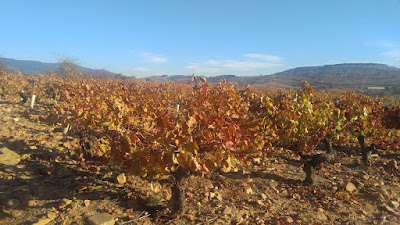If you cleared the Spanish wine map of the famous names (say Rioja, Ribera, Navarra, Priorat and Toro for a start), you'd be left with a huge piece of the country and a long list of barely recognizable regions that, whatever their potential, had been making various grades of plonk for decades and needed to be stirred up, because if you left them to their centuries old tradition in the name of Old World mystique, you'd be left with plonk.
This post is the third in a largely unplanned series about Spanish wines Eldad Levy has been importing to Israel. You could say the producers in the portfolio are some of those that got stirred up. Except for Heredia, a Rioja producer you want to leave alone to continue their proud heritage.
R. Lopez de Heredia (Rioja)
Heredia is one of the last true bastions of old school Riojas. Even the entry level Crianza (from the Cubillo vineyard, whose output is always destined for Crianzas) is aged long enough to legally qualify for a Gran Reserva designation. High scores by Neal Martin have driven prices up (and availability down) but thankfully, these reds are still very sanely priced.
Cubillo, Crianza, 2010
Typical Rioja nose, at least the way it used to be. Slightly earthy, spicy, old wood, slightly meaty. Mellow palate, elegant. 139 NIS.
Tondonia, Reserva, 2006
I've learned the hard way how long these need in the fridge. The nose is a little muted now, and it's still rough on nose and palate. Would need 5 years at least and keep much longer. 220 NIS.
Bosconia, Reserva, 2007
The nose is full of Rioja magic that defies an easy breakdown into descriptors. The wood is almost fully integrated. Will keep as long as the Tondonia but readier for drinking now. At any rate, the contrast in texture is obvious, this is feminine without loss of structure (the fruit and bright acidity make sure the tannins are unobtrusive, thus the structure is deceptively soft) , whereas the Tondonia is rough and still oaky. 175 NIS.
Zarate (Rias Baixas)
Actually, the ordinary plonk Rias Baixas had been making was always very good plonk. It's just that I never drank anything that broke through a certain glass ceiling of good bistro wines until I drank the Zarate Palomar 2016. I thought then, and I think now, that it's the Grand Cru of Albariño.
Albariño, 2018
Fruity, summer fruits, excellent bistro fare. 99 NIS.
Balado, 2017
Similarly styled to the regular Albariño, but lightly tinged with minerals and fuller, yet more nuanced. 175 NIS.
Palomar, 2017
Still needs time, with great potential for a showcase of minerals to make us swoon. Let me put it this way, the Balado is a candidate for the best Albariño ever, while the Palomar, with some age, is beyond such pigeon holes. 185 NIS.
Guimaro (Ribeira Sacra)
Yes, I never heard of Ribeira Sacra before 2018, either. And I still don't know a lot about the place, except their grape of choice is Mencia, another trendy grape sommeliers and writers like to compare to Pinot Noir.
Maixeman, 2017
I always liked this winery but already this is the most enjoyable wine I’ve had from them so far. Only fair complexity but great character. Spicy, no overt wood. 149 NIS.
Pombeiras, 2017
Capelinos, 2017
Both are dry and austere. They’re good and interest me, for their abundant display of minerals, but I can’t quite read them yet or really tell them apart. I would just like to say that here, Mencia comes off more like Cabernet Franc than Pinot. 235 NIS.
Veronica Ortega (Bierzo)
Bierzo has actually been trendy for about five years, mostly for, again, Mencia. I tried Bierzos a few times, liked them well enough, but never swooned. Until I tried the Cobrana.
Quite, 2016
Fun wine. More expressive right now than the Guimaros. A more direct and floral style, slightly earthy. 106 NIS.
Roc, 2016
A varietal Mencia, Slightly heady yet restrained at the same time, with notes of meat and spices. 189 NIS.
Cobrana, 2017
A whole cluster field blend (Mencia and red and white grapes). It has the same complexity, firm-yet-mellow structure and autumnal forest floor nuances of a fine Burgundy. The flavors and velvety mouthfeel are especially a treat, even at a tasting where every wine was delicious. Just about the best red of the tasting. Also the best Mencia or Mencia blend I have ever tasted. 159 NIS.
Cal, 2017
Pure Godello. The salt and minerals make me think of cross between Chablis and Muscadet, with brighter fruit than either, more tropical. I’d drink it now as is. 169 NIS.
Borja Perez (Tenerife)
I wrote about Perez a few weeks ago, so I won't avoid the repetition. All you need to know is that even though the Canary Islands' have the most unlikely geographical coordinates for vine growing, the heights of the vineyards, some cloud coverage and volcanic soil make for the biggest surprise I experienced this year. I posted detailed notes about the Listran Blanco, 2017, the Viduanos, 2017 and the Tinto, 2017 so I'll skip them here and go straight for the one wine I hadn't drunk before.
Babaso Negro, 2016
Floral, very nubile the fruit is so luscious and sexy it almost feels unformed. Think of a young Chambolle, where all you get is roses and can’t really get a sense of structure, but you just know it will stab your heart in five-ten years. Same thing here, except that when it peaks, it will be hard to compare it to anything else. 285 NIS.


Comments